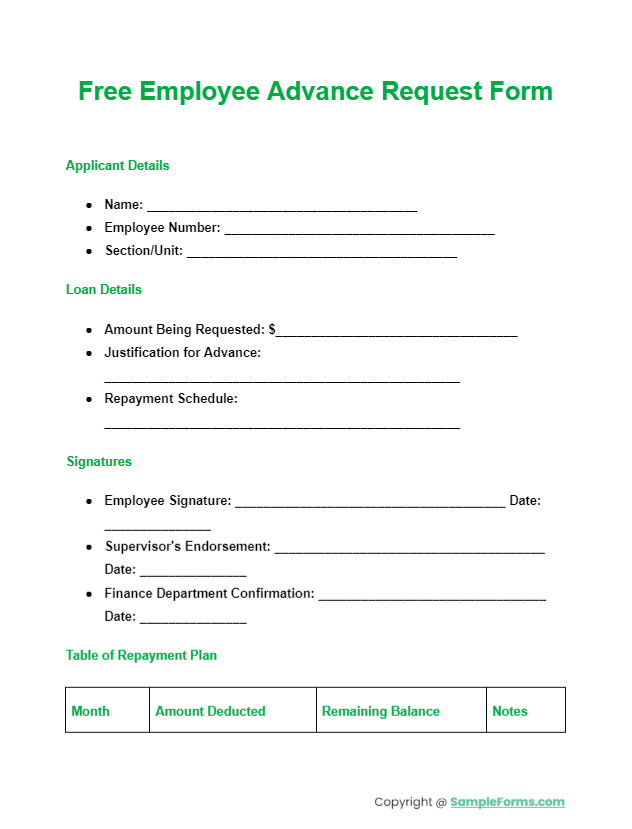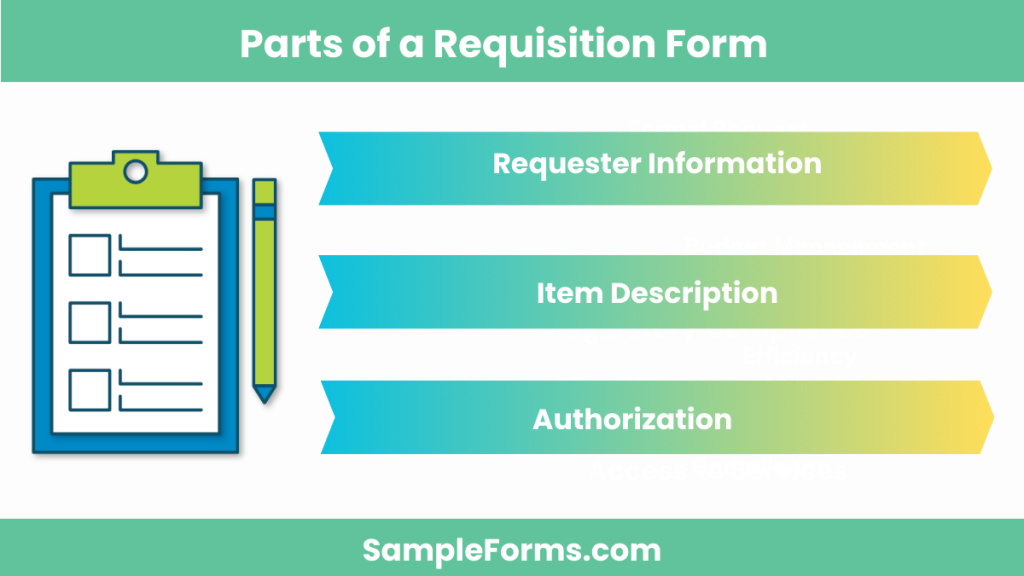
An Employee Advance Request Form is a critical document within organizations that allows employees to request a salary advance due to various reasons. This guide will cover everything from the basics of drafting the form to understanding the company’s policies on advances. By integrating keywords like Request Form and Employee Form, the content will enrich your knowledge about structuring these requests effectively. Examples included in the guide will demonstrate how to fill out the form correctly, ensuring clarity and compliance with HR requirements, thus streamlining the advance process within a corporate setting.

An Employee Advance Request Form is a formal document used by employees to request a portion of their earnings before the usual payday. It typically outlines the amount requested and the reason for the advance, ensuring transparency between the employer and the employee. This form serves as a structured way for staff to manage unexpected financial needs responsibly, maintaining professional decorum and clear communication within the company’s financial policies.

This template provides a structured format for employees to request salary advances, integrating an Employee Bio Data Form to ensure all personal details are updated and accurate for processing.

Our Word template for an Employee Advance Request streamlines the process of requesting a pay advance, ensuring that all necessary information, akin to an Employee Information Form, is included for quick review and approval.

Download our PDF version of the Employee Advance Request Form, designed to be filled out easily and securely, incorporating aspects of an Employee Evaluation Form to link employee performance with advance eligibility.

Access our free, downloadable Employee Advance Request Form, perfect for small businesses or startups. This form includes essential fields similar to an Employee Write Up Form, allowing for detailed explanations and justifications of the advance request.

newschool.edu
File Format
ic.edu.lb
File Format employee travel advance request form" width="390" height="474" />
employee travel advance request form" width="390" height="474" />
sandiego.edu
File Format
kennesaw.edu
File Format
scusd.edu
File Format
ufv.ca
File Format
newarkandsherwood.nhs.uk
File FormatEmployment Verification Form are used on current or erstwhile employees by an employer for government agencies, mortgage lenders, prospective employers, collection agents, and others. They usually seek to verify employment dates, wages, likelihood of continued employment or qualifications for rehire, and reason for termination. Only genuine, supportable information should be shared, regardless of whom it is given. If truthful information is given in good faith, the employer will likely be shielded from any kinds of libelous claims. A signed consent from the employee should be obtained when possible in line with some state immunity laws requiring consent to be protected. You should also take a look at our Employee Witness Statement Form
A request from a government agency often cites a ruling requiring the information; if not, the employers can mostly feel confident about sharing the information asked for, as a good faith effort to comply. These requests are often to verify wages for court decisions (such as child support) or government programs, to divulge dishonest use of government services, or even to help an employee prove that his or her identity was stolen. These requests are usually very detailed in terms of the information needed, and again, any reliable information provided should not subject the employer to legal claims. You should also take a look at our Employee Discipline Form
The employee advance process involves a formal procedure to request early salary disbursement, similar to an Employee Grievance Form.
Processing a payroll advance requires clear guidelines, akin to handling an Employee Complaint Form.
An employee advance for expenses facilitates work-related expenditures, similar to uses detailed in an Employee Shift Change Form.

Recording advances to employees ensures financial accuracy, similar to an Employee Resignation Form in its need for detail.

A requisition form, like an Employee Declaration Form, includes crucial segments for processing requests.
The steps of a requisition mimic systematic processes like those in an Employee Suggestion Form.
Requesting money from your boss involves clear communication, much like an Employee Engagement Survey Form.
An advance requisition form is used to formally request funds before they are due, typically for anticipated expenses, akin to an Employee Expense Reimbursement Form.
To request a payroll advance, fill out the necessary form, specify the amount, explain the urgency, and submit it for approval, similar to an Employee Action Form.
A cash advance request form is a document employees use to request money against their future earnings, similar to the process in an Employee Correction Form.
Asking for a pay advance is acceptable if handled professionally and the company has provisions for it, akin to an Employee Termination Checklist which ensures procedure compliance.
In HR, a requisition form is used to request resources, including staffing or equipment, integral to operations like an Employee Tracking Form.
The requisition form is typically filled out by the department manager or the employee who identifies the need, much like an Employee Election Form is used for decision-making.
The purpose of an advance is to provide employees with immediate financial resources for urgent expenses, similar to an Employee Training Assessment Form that aids in immediate training needs.
In conclusion, an Employee Reimbursement Form is essential in any organization’s financial toolkit. By providing clear samples, comprehensive forms, and detailed guidance, businesses can streamline the reimbursement process. These documents ensure that employees are fairly compensated for out-of-pocket expenses incurred on behalf of the company. Utilizing standardized forms and letters not only simplifies the submission and approval process but also aids in maintaining transparent and accurate financial records. Proper use of these forms reinforces trust and accountability, ensuring that both employees and the company are protected and operations run smoothly.